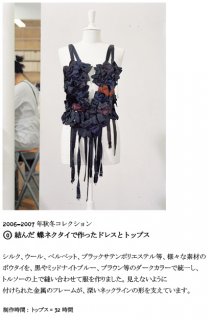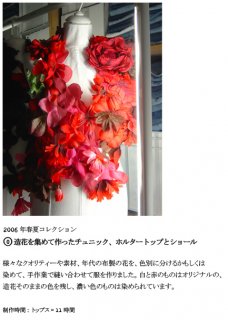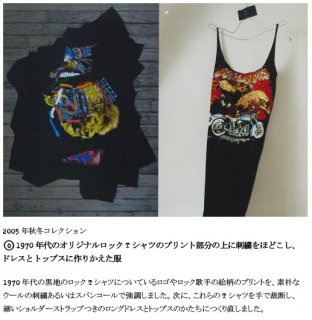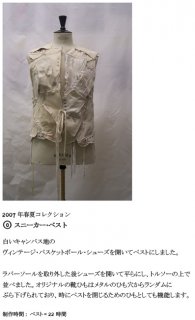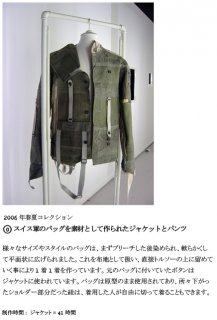margielamike2004
Well-Known Member
- Joined
- May 2, 2005
- Messages
- 582
- Reaction score
- 149
Here is my summation of MMM...past, present, and future.
I'm not exactly sure what the title of this post was intended for. Please forgive me if this post belongs somehere else, under a different post.
Considering I might be one of the earliest collectors of Martin Margiela on The Fashion Spot, I have watched the evolution of Martin's company, for many, many years.
I have made comments on several posts about MMM and other designers as well, throughout the years I've been on TFS.
It's sorta complicated to describe and encapsulate over 25 years of fashion, specificly MMM, in one single post...but I will attempt to give my condensed version of my story, and my perspective.
Martin Margieal and his peers..including Dries Van Noten, Dirk Bikkemberg, Walter Van Bierendonck, Marina Yhee, and Ann Demeulemeester began their careers inthe early 1980's...a time in fashion that could be viewed as considerably commercial. It was a time where Versace, Thierre Mugler, J.P. Gaultier, etc etc reigned surpreme. During that time, most of the fashion industry was not overly concerned with a group of designers who presented too much black, and too much elusiveness within their fashion aesthetic. That realm of fashion was mostly reserved for designers such as Comme Des Garcons, Yohji Yamamoto, Issey Miyaki, Matsuda..and they catered to be very specific clientele, that being not the mass-majority. Whenever the Belgians presented their collections, many of them were not looked upon, or seen as, being significant. Most of them refused to conduct interviews (many of them still do)..and many of them were not particularly interested in describing the story within their collections.
The fashion industry in itself can be a very difficult world to live in. As many of you (I'm sure) understand, it can be a diffult place where one can survive. There is plenty of competition out there, and it takkes plenty of money in order to survive. In order for someone to make money..one nneds to have money. As they say.."It takes money, to make money."
There are many designer collections who's main focus is to generate profits. You see their 5-page spreads in every fashion magazine that you might flip through, because the subject of fashion (in itself) has become "more fashionable." There are many many more people who love fashion, than there were 20 years ago. Fashion has become, more fashionable. In order for someone to survive (especially today), one usually needs heavy financial backing, a great PR system, at times a celebrity (or runway-supermodel) to atttact attention. All of the aforementioned, are subjects that many of the Belgians (and the Japanese) didn't aspire to. None of them used logo's or advetisements to attract attention, or status. Their primary objective was to follow their hearts, not following current trends, using fabrics in non-traditional constructions, etc etc. Every designer certainly needs to make money in order to survive...but, it can also be like a catch-22. Do you sell your company for millions of dollars to a corporate company that can make your collection grow...or, do you refuse to "sell-out", rely upon word-of-mouth in order to be recognized, collecting small profits from a very small clientele, and a very tiny demographic??
As far as Martin Margiela...I knew I could smell trouble on the horizon after the Diesel Corp buy out strategy. The Diesel Corp is certainly a great company, so I'm not going to tarnish its image, or its history (I was wearing Diesel jeans in the late 1980's)...but Renzo Rosso has become a power-house buyer within the fashion industry.
I genuinely believe that Renzo Rosso never meant to harm Martin Margiela. For a long time, MMM was suffering financially during its early years. Renzo himself has always encouraged and supported creativity. I think the only irony about MMM and the Diesel Corp are their aesthetics. Bluntly speaking, Renzo loves (and realizes the need in today's world) to advertise...MMM, is the opposite.
If Martin Margiela walked away from what he created, he definitely in NOT the first and only designer, to do so. It has happened in the past with Helmut Lang (Prada bought his company, disected it, then sold it)...also, Jil Sander (also bought by Prada) who refused to negotiate, sold her company, and walked away (which is now being designed by Raf Simons, another Belgian designer.)
Sorry if this post is a bit confusing and in-coherent...but I'm finding it difficult to explain what I'd like to explain. Sorry.
I'm not exactly sure what the title of this post was intended for. Please forgive me if this post belongs somehere else, under a different post.
Considering I might be one of the earliest collectors of Martin Margiela on The Fashion Spot, I have watched the evolution of Martin's company, for many, many years.
I have made comments on several posts about MMM and other designers as well, throughout the years I've been on TFS.
It's sorta complicated to describe and encapsulate over 25 years of fashion, specificly MMM, in one single post...but I will attempt to give my condensed version of my story, and my perspective.
Martin Margieal and his peers..including Dries Van Noten, Dirk Bikkemberg, Walter Van Bierendonck, Marina Yhee, and Ann Demeulemeester began their careers inthe early 1980's...a time in fashion that could be viewed as considerably commercial. It was a time where Versace, Thierre Mugler, J.P. Gaultier, etc etc reigned surpreme. During that time, most of the fashion industry was not overly concerned with a group of designers who presented too much black, and too much elusiveness within their fashion aesthetic. That realm of fashion was mostly reserved for designers such as Comme Des Garcons, Yohji Yamamoto, Issey Miyaki, Matsuda..and they catered to be very specific clientele, that being not the mass-majority. Whenever the Belgians presented their collections, many of them were not looked upon, or seen as, being significant. Most of them refused to conduct interviews (many of them still do)..and many of them were not particularly interested in describing the story within their collections.
The fashion industry in itself can be a very difficult world to live in. As many of you (I'm sure) understand, it can be a diffult place where one can survive. There is plenty of competition out there, and it takkes plenty of money in order to survive. In order for someone to make money..one nneds to have money. As they say.."It takes money, to make money."
There are many designer collections who's main focus is to generate profits. You see their 5-page spreads in every fashion magazine that you might flip through, because the subject of fashion (in itself) has become "more fashionable." There are many many more people who love fashion, than there were 20 years ago. Fashion has become, more fashionable. In order for someone to survive (especially today), one usually needs heavy financial backing, a great PR system, at times a celebrity (or runway-supermodel) to atttact attention. All of the aforementioned, are subjects that many of the Belgians (and the Japanese) didn't aspire to. None of them used logo's or advetisements to attract attention, or status. Their primary objective was to follow their hearts, not following current trends, using fabrics in non-traditional constructions, etc etc. Every designer certainly needs to make money in order to survive...but, it can also be like a catch-22. Do you sell your company for millions of dollars to a corporate company that can make your collection grow...or, do you refuse to "sell-out", rely upon word-of-mouth in order to be recognized, collecting small profits from a very small clientele, and a very tiny demographic??
As far as Martin Margiela...I knew I could smell trouble on the horizon after the Diesel Corp buy out strategy. The Diesel Corp is certainly a great company, so I'm not going to tarnish its image, or its history (I was wearing Diesel jeans in the late 1980's)...but Renzo Rosso has become a power-house buyer within the fashion industry.
I genuinely believe that Renzo Rosso never meant to harm Martin Margiela. For a long time, MMM was suffering financially during its early years. Renzo himself has always encouraged and supported creativity. I think the only irony about MMM and the Diesel Corp are their aesthetics. Bluntly speaking, Renzo loves (and realizes the need in today's world) to advertise...MMM, is the opposite.
If Martin Margiela walked away from what he created, he definitely in NOT the first and only designer, to do so. It has happened in the past with Helmut Lang (Prada bought his company, disected it, then sold it)...also, Jil Sander (also bought by Prada) who refused to negotiate, sold her company, and walked away (which is now being designed by Raf Simons, another Belgian designer.)
Sorry if this post is a bit confusing and in-coherent...but I'm finding it difficult to explain what I'd like to explain. Sorry.




![_1_reference[1].jpg](https://thefashionspot-data.community.forum/attachments/786/786119-ca62e4cb0ccd18e5df81f9aa7382a935.jpg?hash=ymLkywzNGO)
